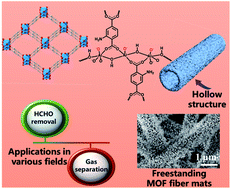Fabrication of a freestanding metal organic framework predominant hollow fiber mat and its potential applications in gas separation and catalysis†
Abstract
Recently, metal–organic framework (MOF)-based polymeric substrates show promising performance in many engineering and technology fields. However, a commonly known drawback of MOF/polymer composites is MOF crystal encapsulation and reduced surface area. This work reports a facile and gentle strategy to produce self-supported MOF predominant hollow fiber mats. A wide range of hollow MOFs including MIL-53(Al)–NH2, Al-PMOF, and ZIF-8 are successfully fabricated by our synthetic method. The synthetic strategy combines atomic layer deposition (ALD) of metal oxides onto polymer fibers and subsequent selective removal of polymer components followed by conversion of remaining hollow metal oxides into freestanding MOF predominant hollow fiber structures. The hollow MOFs show boosted surface area, superb porosity, and excellent pore accessibility, and exhibit a significantly improved performance in CO2 adsorption (3.30 mmol g−1), CO2/N2 separation selectivity (24.9 and 21.2 for 15/85 and 50/50 CO2/N2 mixtures), and catalytic removal of HCHO (complete oxidation of 150 ppm within 60 min).



 Please wait while we load your content...
Please wait while we load your content...